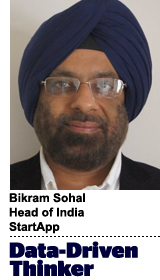 “Data-Driven Thinking” is written by members of the media community and contains fresh ideas on the digital revolution in media.
“Data-Driven Thinking” is written by members of the media community and contains fresh ideas on the digital revolution in media.
Today’s column is written by Bikram Sohal, head of India at StartApp.
The timeless tenet that understanding customers is the key to business growth has never been truer than within India’s rapid acceleration into a mobile-first giant.
The pace of change that has made the nation an overnight ecommerce hotspot has captured the attention of smart mobile marketers who now face the challenge of how to deliver app-based content that appeals to the culture of a customer on the other side of the globe.
Established app markets have already become oversaturated and the shelf life of a mobile app can be short. Nearly a quarter of apps are used once and then left unused or deleted. Developers search for the secret to give their mobile apps true staying power, but in the end most of us only have a handful of apps that we use day in and day out; we spend half our time using only five apps.
However, disruption always lurks around the corner in mobile. That’s never been more evident than in India, where mobile device adoption put the nation on its current course toward being the largest ecommerce market.
In three years, online connectivity in India has increased by a third, largely driven by subsidized, unlimited 4G access introduced by Reliance Jio in September 2016. That increased connectivity has intersected with falling costs for smartphones and mobile data, which are half of what they cost two years ago.
With India’s 355 million smartphone users already online, the nation is starting to show that certain strategies can shift the paradigm of app stickiness. What’s most prominently emerging as a winning strategy is delivering mobile content that’s in-tune with the local culture. The publishers who keep India’s users top-of-mind in their apps and marketing will effectively keep users from moving on to the next best app that comes along.
Going local
Many predict India to continue its climb toward becoming the world’s top ecommerce market and, in suit, the fastest-growing market for mobile apps. India overtook the US to become the No. 2 country by downloads in 2017. The nation will hit 500 million internet users this month, and it seems the country won’t reverse direction anytime soon.
To ensure mobile apps can keep pace, app developers need to refine app specifications based on locality. Brands that localize content for India’s consumers, in both content and language, are developing deeper, more valuable consumer engagement.
Vying for space
There may be more mobile devices worldwide – with nearly 5 billion users so far in 2018 – but most are low-cost mobile phones with minimal space to download applications. That isn’t likely to be an issue in India for long, given Google’s plans to release a mid-range Pixel phone in India this summer. For now, publishers need to shrink their apps to spare themselves from the dreaded “deleted for more space.” This optimization of content will go far toward ensuring these apps live longer.
Creating an app advantage
India will continue to shift expectations as the mobile phenomena attracts more interest, such as Walmart’s recent $16 billion dollar acquisition of India’s leading online retailer, Flipkart. That alone signals a shift in ecommerce, a space that will evolve over time, following some of the same patterns of mobile proliferation in other markets.
India’s mobile users are flocking to video streaming apps, with Netflix among the top apps in India based on revenue. Social media and messaging apps are also neck and neck on the rise, with Facebook, Facebook Messenger and WhatsApp ranked in the top 10 most-downloaded apps.
Of course it’s just as important to understand what types of apps and content aren’t being downloaded, including sports and transportation apps. The apps poised to gain the most ground within local markets will focus on local vernacular. An April 2017 report by Google and KPMG projected vernacular internet content consumers would grow 129% to 536 million between 2016 and 2021. In comparison, English-language users are likely to grow a meager 14% to 199 million in the same period. One company already capitalizing on the use of local vernacular, Dailyhunt, almost doubled its revenue in fiscal 2016.
By employing a localization-first strategy, publishers can better deliver user experiences that evolve with the rapidly changing trends in the mobile space. In an increasingly globalized world, localization based on understanding the consumer behavior can help mobile apps scale globally and cross the chasm of physical and cultural divides.
Follow StartApp (@StartApp) and AdExchanger (@adexchanger).












